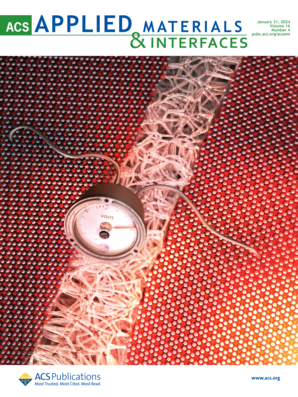非预期MoO3/Al界面反应降低有机太阳能电池热退火性能及抑制方法
IF 8.3
2区 材料科学
Q1 MATERIALS SCIENCE, MULTIDISCIPLINARY
引用次数: 0
摘要
了解有机太阳能电池的降解机理并提高其热稳定性对这种新型光伏技术至关重要。在这项工作中,我们发现,由于 VOC 和 FF 的快速衰减,高性能聚合物太阳能电池在 150 °C 的热退火过程中会出现明显的性能衰减。我们证明,热退火过程会导致 MoO3 与 Al 发生严重的化学反应,在 MoO3/Al 界面形成 Al2O3 阻挡层,从而降低电池的内置电位 (Vbi),进而降低电荷收集效率。在 MoO3/Al 之间插入一层薄的 C60 中间膜,可减缓 MoO3 与 Al 的化学反应,从而确保退火的 MoO3/C60/Al 电池具有较高的 Vbi 和电荷收集效率。对于具有不同聚合物光活性层和金属电极的电池,我们也证实了 C60 层在提高器件性能以抵御热退火方面的保护作用,这证明了电池界面降解和 C60 层保护作用的普遍性。最后,我们证明了使用 C60 改性阳极的倒置聚合物太阳能电池在高温热压封装后几乎没有性能衰减,这表明这种新型器件结构具有出色的耐热性。本文章由计算机程序翻译,如有差异,请以英文原文为准。

Unexpected MoO3/Al Interfacial Reaction Lowering the Performance of Organic Solar Cells upon Thermal Annealing and Methods for Suppression
Understanding the degradation mechanism and improving the thermal stability of organic solar cells are essential for this new photovoltaic technology. In this work, we found that the high-performance polymer solar cells suffer from significant performance decay upon thermal annealing at 150 °C owing to the fast decay of VOC and FF. We demonstrated that the thermal annealing process leads to a severe chemical reaction of MoO3 with Al, forming an Al2O3 barrier layer at the MoO3/Al interface, which lowers the built-in potential (Vbi) of the cells and consequently reduces charge collection efficiency. Inserting a thin C60 interlayer between MoO3/Al slows the chemical reaction of MoO3 with Al, which ensures a high Vbi and charge collection efficiency for the annealed MoO3/C60/Al cells. Such a protection effect of the C60 layer in improving device performance against thermal annealing was also confirmed for cells with different polymer photoactive layers and metal electrodes, demonstrating the generality of the interfacial degradation of the cells and the protection effect of the C60 layer. Finally, we demonstrated that the inverted polymer solar cells with the C60-modified anode showed almost no performance decay upon high-temperature hot-press encapsulation, demonstrating excellent heat tolerance of this new device structure.
求助全文
通过发布文献求助,成功后即可免费获取论文全文。
去求助
来源期刊

ACS Applied Materials & Interfaces
工程技术-材料科学:综合
CiteScore
16.00
自引率
6.30%
发文量
4978
审稿时长
1.8 months
期刊介绍:
ACS Applied Materials & Interfaces is a leading interdisciplinary journal that brings together chemists, engineers, physicists, and biologists to explore the development and utilization of newly-discovered materials and interfacial processes for specific applications. Our journal has experienced remarkable growth since its establishment in 2009, both in terms of the number of articles published and the impact of the research showcased. We are proud to foster a truly global community, with the majority of published articles originating from outside the United States, reflecting the rapid growth of applied research worldwide.
 求助内容:
求助内容: 应助结果提醒方式:
应助结果提醒方式:


